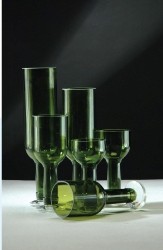Zuzana Labudová
Members of the jury of this competitive exhibition were first of all charged with the task of selecting the collection from works entered for the exhibition. The selection of the exhibiting authors was conditional on membership of the Slovak Fine Arts Union. Already in its first- round selection it was clear that the level of works of roughly 60 registered authors varied (clearly seen for example in ceramics) and only about a half of them made it to the short list. This was not merely due to the application of quality criteria in picking the works but also of the utility requirement, which the jury consistently took into consideration. The works should display a combination of utility function and artistic rendition with the imprint of the creator’s individuality that results in author originals.
The applied arts disciplines – graphic arts, photography, textile, ceramics, glass, design and jewel – were very unevenly represented. A small turnout of only one or two authors was seen in the disciplines of glass and ceramics. On the other hand, the participation of the jewellery making community displayed a broader range of ideas and enabled confrontation of older, middle and more plentifully represented younger generation of jewellery makers. Another quite strong group, textile, was represented by a number of genres. During selection the jury found the boundaries of utility in photography to be questionable and unclear. The graphic design was presented in different positions, from the author book design, through exhibition visuals to advertising posters. Tibor Uhrín, the winner of the exhibition (the Grand Prix) presented at the biennial the thinly represented design.
The closed platform of the exhibiting authors, limited by membership, has proved to be negative in this case and has thus failed in becoming a direct reflection of current events. Though the jury may have considerably reduced the number of exhibiting authors after selection it might be seen as a kind of seeking for and regulating the standards for the next editions to come.
